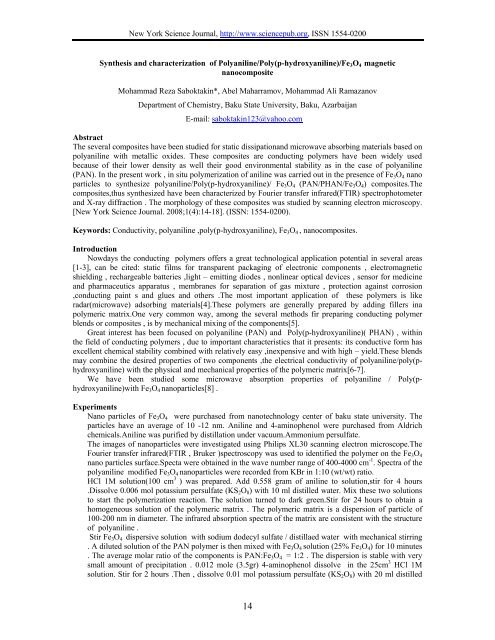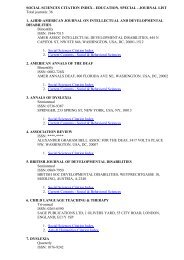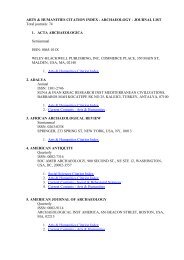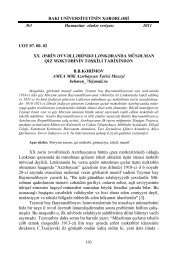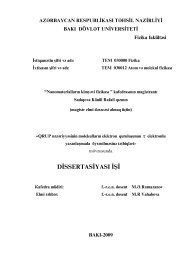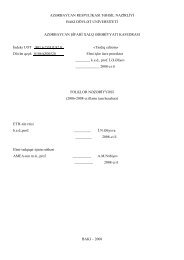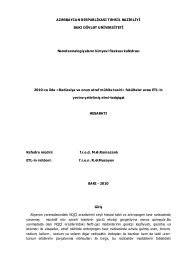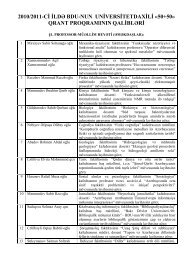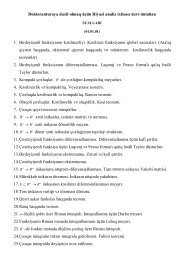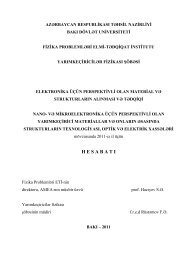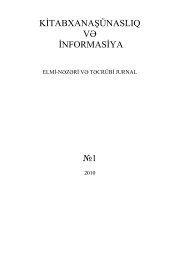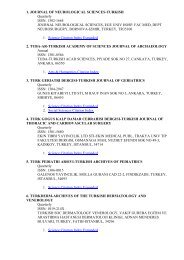Mohammad Reza Saboktakin, Abel Maharramov, Mohammad Ali ...
Mohammad Reza Saboktakin, Abel Maharramov, Mohammad Ali ...
Mohammad Reza Saboktakin, Abel Maharramov, Mohammad Ali ...
- No tags were found...
Create successful ePaper yourself
Turn your PDF publications into a flip-book with our unique Google optimized e-Paper software.
New York Science Journal, http://www.sciencepub.org, ISSN 1554-0200Synthesis and characterization of Polyaniline/Poly(p-hydroxyaniline)/Fe 3 O 4 magneticnanocomposite<strong>Mohammad</strong> <strong>Reza</strong> <strong>Saboktakin</strong>*, <strong>Abel</strong> <strong>Maharramov</strong>, <strong>Mohammad</strong> <strong>Ali</strong> RamazanovDepartment of Chemistry, Baku State University, Baku, AzarbaijanE-mail: saboktakin123@yahoo.comAbstractThe several composites have been studied for static dissipationand microwave absorbing materials based onpolyaniline with metallic oxides. These composites are conducting polymers have been widely usedbecause of their lower density as well their good environmental stability as in the case of polyaniline(PAN). In the present work , in situ polymerization of aniline was carried out in the presence of Fe 3 O 4 nanoparticles to synthesize polyaniline/Poly(p-hydroxyaniline)/ Fe 3 O 4 (PAN/PHAN/Fe 3 O 4 ) composites.Thecomposites,thus synthesized have been characterized by Fourier transfer infrared(FTIR) spectrophotometerand X-ray diffraction . The morphology of these composites was studied by scanning electron microscopy.[New York Science Journal. 2008;1(4):14-18]. (ISSN: 1554-0200).Keywords: Conductivity, polyaniline ,poly(p-hydroxyaniline), Fe 3 O 4 , nanocomposites.IntroductionNowdays the conducting polymers offers a great technological application potential in several areas[1-3], can be cited: static films for transparent packaging of electronic components , electromagneticshielding , rechargeable batteries ,light – emitting diodes , nonlinear optical devices , sensor for medicineand pharmaceutics apparatus , membranes for separation of gas mixture , protection against corrosion,conducting paint s and glues and others .The most important application of these polymers is likeradar(microwave) adsorbing materials[4].These polymers are generally prepared by adding fillers inapolymeric matrix.One very common way, among the several methods fir preparing conducting polymerblends or composites , is by mechanical mixing of the components[5].Great interest has been focused on polyaniline (PAN) and Poly(p-hydroxyaniline)( PHAN) , withinthe field of conducting polymers , due to important characteristics that it presents: its conductive form hasexcellent chemical stability combined with relatively easy ,inexpensive and with high – yield.These blendsmay combine the desired properties of two components ,the electrical conductivity of polyaniline/poly(phydroxyaniline)with the physical and mechanical properties of the polymeric matrix[6-7].We have been studied some microwave absorption properties of polyaniline / Poly(phydroxyaniline)withFe 3 O 4 nanoparticles[8] .ExperimentsNano particles of Fe 3 O 4 were purchased from nanotechnology center of baku state university. Theparticles have an average of 10 -12 nm. Aniline and 4-aminophenol were purchased from Aldrichchemicals.Aniline was purified by distillation under vacuum.Ammonium persulfate.The images of nanoparticles were investigated using Philips XL30 scanning electron microscope.TheFourier transfer infrared(FTIR , Bruker )spectroscopy was used to identified the polymer on the Fe 3 O 4nano particles surface.Specta were obtained in the wave number range of 400-4000 cm -1 . Spectra of thepolyaniline modified Fe 3 O 4 nanoparticles were recorded from KBr in 1:10 (wt/wt) ratio.HCl 1M solution(100 cm 3 ) was prepared. Add 0.558 gram of aniline to solution,stir for 4 hours.Dissolve 0.006 mol potassium persulfate (KS 2 O 8 ) with 10 ml distilled water. Mix these two solutionsto start the polymerization reaction. The solution turned to dark green.Stir for 24 hours to obtain ahomogeneous solution of the polymeric matrix . The polymeric matrix is a dispersion of particle of100-200 nm in diameter. The infrared absorption spectra of the matrix are consistent with the structureof polyaniline .Stir Fe 3 O 4 dispersive solution with sodium dodecyl sulfate / distillaed water with mechanical stirring. A diluted solution of the PAN polymer is then mixed with Fe 3 O 4 solution (25% Fe 3 O 4 ) for 10 minutes. The average molar ratio of the components is PAN:Fe 3 O 4 = 1:2 . The dispersion is stable with verysmall amount of precipitation . 0.012 mole (3.5gr) 4-aminophenol dissolve in the 25cm 3 HCl 1Msolution. Stir for 2 hours .Then , dissolve 0.01 mol potassium persulfate (KS 2 O 8 ) with 20 ml distilled14
New York Science Journal, http://www.sciencepub.org, ISSN 1554-0200water. Mix these two solutions to start the polymerization reaction. The solution turned to darkgreen.Stir for 24 hours to obtain a homogeneous solution of the polymeric matrix.The viscosity ofsolution is increased.Results and DiscussionSEM of polyaniline/ Poly(p-hydroxyaniline)/ Fe 3 O 4 nanocomposite synthesized by chemicaloxidative is shown in Figure 1. PAN/ PHAN / Fe 3 O 4 nanocomposite is very sensitive to the temperature .Due to the intractionelectron and sample . Scanning electron micrography images were obtains from adiluted solution of the nanocomposite particle . The white spots are Fe 3 O 4 nano particles .The SEM imageshows the presence of spherical Fe 3 O 4 particles in PAN/ PHAN matrix, which are homogenenouslydistributed throughout the composites ,which is also confirmed from XRD studies[11]. A very highmagnification of SEM image shows the presence of spherical Fe 3 O 4 particles(cenospheres ) in PAN/ PHAN, which are homogeneously distributed throughout the composites ,which is also confirmed from XRDstudies .It is for the first time such a beautiful distribution of cenospheres is observed which looks as if thebeads are floating over the water surface . These ceospheres show a large variation in theirdimensions.Since the partices of Fe 3 O 4 are spherical in shape ,the observed porosity in these composites isless than the other PAN/ PHAN composites .Figure 1. Scanning electron micrograph of PAN: PHAN:Fe 3 O 4 nanocompositeThe crystallinity of the formed composites was followed with X-Ray diffraction(XRD) as sfunction of weight percent inorganic component. Figure 2a shows X-ray diffraction pattern of polyaniline.Diffraction of PAN: PHAN have a broad peak at about 2Ө = 25.92 ˚ , which is a characteristic peak ofPAN: PHAN (Wan et al 1994 , Wan and li 1998) . Studies on XRD patterns of PAN: PHAN are scarce inthe literature(Rajendra Prasad and Muunichandriah 2002 ) .Figure 2b shows the XRD pattern for PAN:PHAN:Fe 3 O 4 (25% ). The diffraction pattern of PAN: PHAN: Fe 3 O 4 nanocomposite shows a peak at about2Ө = 26.89˚[12,13].15
New York Science Journal, http://www.sciencepub.org, ISSN 1554-0200Figure2. XRDPAN: PHAN: Fe 3 O 4 nanocompositespectra ofFigure 3a shows the FT-IR spectrum of pure polyaniline nanopolymer , where the % oftransmittance is plotted as a function of wave number (cm -1 ) . The characteristic FT-IR peak at 1523 and1485 cm -1 are due to the presence of quinoid and benzenoid rings , respectively and are clear indication ofthese two states in the polymer chain. Also , The peaks at 1176 cm -1 are due to the C-N bond stretchingvibration ,respectively[14] .Figure3a. FT-IRpolyanilinespectra of pureAlso,figure 3b shows the FT-IR spectrum of polyaniline-poly(4-aminophenol) nanocomposite inpresence of Fe 3 O 4 as a ferromagnetic material exhibit new absorption peaks distinctly at1591,1485,1382,1178 and 760 cm -1 which are assignable to the presence of various metal oxides in thecomposite.The broad peaks at 3200-3500 cm -1 are O-H Phenolic group in the nanocomposite.16
New York Science Journal, http://www.sciencepub.org, ISSN 1554-0200Figure3b. FT-IRPHAN: Fe 3 O 4 nanocompositespectra of PAN:The effect of Fe 3 O 4 particles on the electrical conductivity of PAN/ PHAN / Fe 3 O 4nanocomposites was studied .These data shows the low frequency behaviour of nanocomposite.Theabsolute conductivity for individual samples increases as a function of frequency except for thenanocomposite with 25 wt% Fe 3 O 4 . The electrical conductivity of pure PAN/ PHAN (0 wt% Fe 3 O 4 ) hasthe order of 10 -4 S/cm. For the PAN/ PHAN /Fe 3 O 4 nanocomposite the conductivity values change the orderof magnitude.(10 -5 S/cm).From FT-IR and XRD studies , the presence of Fe 3 O 4 in nanocomposite areconfirmed[15].ConclusionsWe have synthesized new polyaniline matrix by in situ polymerization in the presence of Fe 3 O 4nano particles .The PAN/ PHAN / Fe 3 O 4 ferromagnetic nanocomposites have been characterized by FT-IR,SEM,and XRD techniques.This nanocomposite show crystalline nature ,whereas the PAN synthezied isamorphous in nature . The SEM photograph of nanocomposite with 25% Fe 3 O 4 show the presence ofcenospheres. These nanocomposites are suitable materials for high technology industries . The organiccomponent is the hybride material have the dimention of 100-200 nm . One type of the composite issynthesized by preparing a precursor that contains the Fe 3 O 4 nano particles.The composites were coated onglass and metal surfaces by the method of layer-by layer coating of self – assembled multi layers.AcknowledgmentThe authors Wish to thank prof. M.Allahverdiev(Baku State University) for Valuable discussions.References1. P.F.W. Simon, R. Ulrich, H.W. Spiess , U. Wiesner, Cem.Mater,13 , 3464 ,2001.2. M.R. <strong>Saboktakin</strong>., A. <strong>Maharramov</strong>, M.,A.,Ramazanov, Nature and Science,2007,5(3), 67-71.3. M.R.<strong>Saboktakin</strong>,A., <strong>Maharramov</strong>, M.,A.,Ramazanov,Journal of AmericanScience,2007, 3(4),40-454. M.R.<strong>Saboktakin</strong>,A., <strong>Maharramov</strong>, M.,A.,Ramazanov,Journal of American Science,2007, 3(4),30-345. B.O’Regan,M.Gratzel, Nature,353,737,1991.6. A.J.Zarur,J.Y.Ying,Nature,403,65,2000.7. J.M.Liu and S.C.Yang, J.Chem.Soc.,Chem.Comm.,1529,1991.8. J.O.Stoffer,T.J.O’Keefe,X.Lin,E.Morris,P.Yu,S.P.Sitaram,US Patent 5,932,083.9. S.P.Sitaram, P.Yu, T.J.O’Keefe and J.O.Stoffer ,Polym.Mater.Sci.Eng.,75,354,1996.10. L.Sun,H.Liu,R.Clark,S.C.Yang,Syn.Met,85,67,1997.17
New York Science Journal, http://www.sciencepub.org, ISSN 1554-020011. J.M.Liu,L.Sun,J.H.Hwang and S.C.Tang,H.L.Wang,Mat.Res. Soc.Symposium Proceeding , 247,601,1992.12. P.A.McCarthy,J.HuAng,S.C.Yang,H.L.Wang, Langmir,18,259,2002.13. Z.Tang ,N.Alvarez and Sze Yang , Mat.Res. Soc.Symposium Proceeding , 732,601,2003.14. S.C.Raghavendra.S.Khasim,M. Revanasiddappa,M.V.N. Ambika Prasad andA.B.KuKarni,Bull.Mater. Sci,26,7,2003.15. S.P.Armes, J.F. Miller,Synth. Met.22,385,2001.2/21/200818


